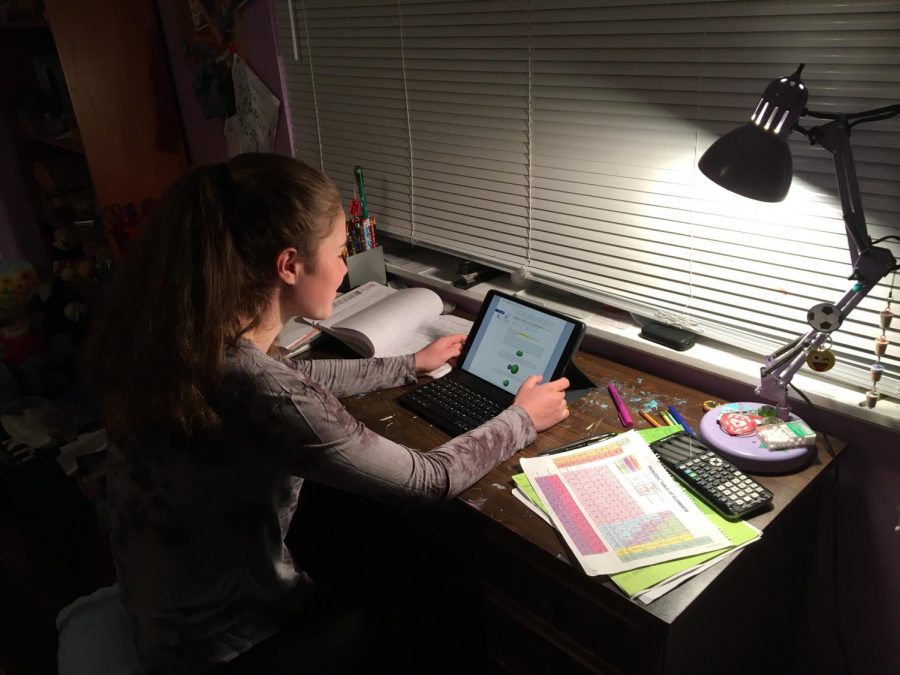Tacoma Students Give Their Input on Virtual Learning
photo courtesy of Emily Smith
Bellarmine student Emily Smith uses the platforms Moodle and Zoom for her online learning weekly from home.
May 1, 2020
It’s been over a month since Annie Wright transitioned to online school. This new learning format is challenging for many, and people have different opinions about the new Microsoft Teams classes. Many other Tacoma schools adapted to new learning formats as well. Inkwell reached out to four students of different Tacoma schools to see how they are adapting to this change.
Bellarmine Preparatory School
Bellarmine Prep junior Emily Smith noted that online school creates more work overall due to the amount of daily assignments and lack of lectures. “It’s a lot more difficult for most people to self motivate rather than being in a classroom environment, so a lot of the time it feels like a lot more work than it actually is.” she said. Smith observed that despite the amount of school work, one benefit to the new format was the ability to sleep longer and schedule the day to fit your own needs. Smith said she generally wakes up at 9am and has hour long classes until 2:30 in the afternoon. “For most classes we use Zoom for most of the time and then a teacher gives us an assignment to do as class work or homework… I typically do about three hours of homework every day.”
Wilson High School
Tacoma’s public schools were hit harder by the school closures. Because their students come from a wide variety of socioeconomic backgrounds, planning for online school was challenging. Wilson High School sophomore Charles Ganu has one video call every day for his AP Euro class. Ganu mentioned that although his other classes give him review work, the lack of in-person connection means less learning overall. “A disadvantage is it’s not very organized and not helpful in pushing students to learn since our grades aren’t affected at all. Unless you were failing the classes you can’t really improve your grades or lower your grades unless certain teachers go against school policy of not making the work count towards your grade.” Although this policy may seem ideal for students at first, Ganu notes that it contributes to a lack of motivation and engagement because there are no repercussions for not doing the work.
Tacoma School of the Arts
Celia Nimura-Parmenter, School of the Arts freshman, noted that without teachers and classmates, the workload feels heavier. “I’d say I have more homework than normal just because I procrastinate… I’m learning less but still learning.” Nimura-Parmenter mentioned that she feels very disconnected from her teachers and classmates, especially because many of her classes focus on performance and expression. “I think everyone’s having a hard time right now with anxiety, depression, lack of motivation, and while it’s important to keep learning I think this is something else we as a society should keep in mind” she added.
Charles Wright Academy
“Our Zoom classes begin at 9am every day and we have classes until 11:45 and we do homework anytime after that and we have office hours for an hour. I wake up at 8 and go to bed pretty late sometimes.” said Lia Kilcup, Charles Wright 8th grader. “I feel like it’s nice to be able to have just one speaker on Zoom or be able to talk without any interruptions, but it’s very difficult to sit in front of a screen for 5-7 hours a day and focus properly. A lot of my peers and I think that the workload has been a little overwhelming… we often tell teachers and advisors about [the stress it adds] and how it feels like more than what we would have had normally.”
Although the new learning formats vary between schools, these students agreed that online school is nice because there is more flexibility in their daily routines, but that it is overall more difficult than in-person learning because of the lack of student engagement.










